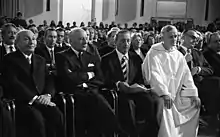Max Tau
Max Tau was a German-Norwegian writer, editor, and publisher.
Max Tau | |
|---|---|
 Max Tau, the lithograph by Emil Stumpp, 1929 | |
| Born | 19 January 1897 |
| Died | 13 March 1976 (aged 79) Oslo, Norway |
| Nationality | Norwegian and German |
| Alma mater | University of Kiel |
| Occupation | Publisher and writer |
| Years active | 1928-1976 |
| Employer | Grundt Tanum, Aschehoug |
| Known for | Building cultural relations between Norway and Germany |
| Spouse(s) | Tove Filseth |
| Parent(s) | Nathan Tau (1870–1941) and Julie Julius (1874–1942 |
Tau grew up in an environment characterized by what he later termed the "Jewish-German" symbiosis, in a Jewish household heavily influenced by the Jewish enlightenment. He studied literature, art history, philosophy, and psychology at universities in Berlin, Hamburg, and Kiel. He earned his doctorate at the University of Kiel, defending a dissertation on the German writer Theodor Fontane. Tau emigrated to Norway and during the Nazi-German occupation of Norway, he was a refugee in Sweden and returned to Norway after the war. He was noted for his contribution to promoting literary exchange between Germany and Norway, especially in the context of reconciliation after World War II. He obtained Norwegian citizenship while in exile in Sweden in 1944.[1]

Credit: Deutsche Bundearchiv
Awards
- 1950 Peace Prize of the German Book Trade
- 1965 Nelly Sachs Prize
- 1970 Sonning Prize
References
- Lorenz, Einhart (2000). "Max Tau". In Helle, Knut (ed.). Norsk biografisk leksikon (in Norwegian). 2. Oslo: Kunnskapsforlaget. Retrieved 21 April 2009.
